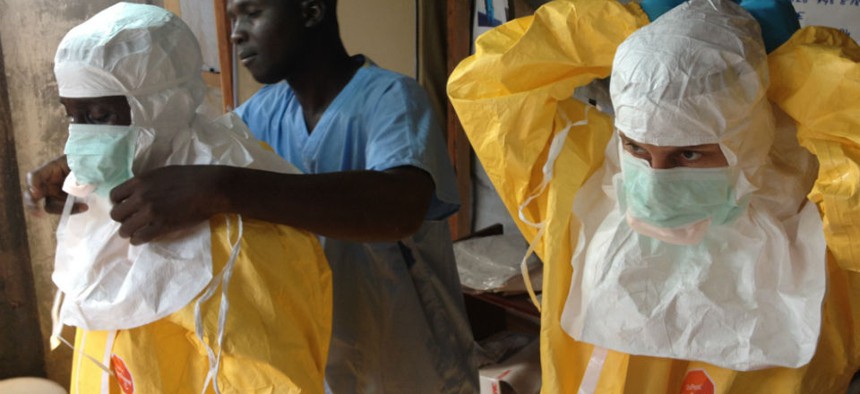
Ebola broke out in Guinea in March, and has now spread across borders to Sierra Leone and other countries in West Africa. Flickr user European Commission DG ECHO
As Ebola Outbreak Spreads in West Africa, U.S. Scientists Look for Cure
Just over a dozen American laboratories can experiment with the deadly virus, and one in Texas reports some promise in animal studies.
There's a lot we don't know about the Ebola virus.
The deadly virus likely comes from fruit bats, but scientists don't know for sure. They also don't know all the ways the highly contagious virus is transmitted, nor how the disease develops within infected people, almost 90 percent of whom will die. And they don't know to treat it or cure it.
Since February, the worst Ebola outbreak Western Africa has ever seen has claimed more than 670 lives, including a prominent Liberia doctor who tried to contain the disease. This month, the virus traveled by plane for the first time, when Patrick Sawyer flew from Liberia to Nigeria, where he died days later from the virus.
As health workers try to contain the growing outbreak in Africa, scientists 6,000 miles away are trying to develop the tools they need to do it.
Researchers at the Galveston National Laboratory in Texas are working to produce three promising vaccines and treatments for the Ebola virus, thanks to a $28 million grant from the National Institutes of Health. The laboratory, operated by the University of Texas Medical Branch, is one of only about 15 facilities that are allowed to store and experiment with Ebola. The virus is classified as a biosafety level 4 agent, the designation given by the Centers for Disease Control and Prevention to the most dangerous agents known to humans. The Galveston laboratory, and other biosafety level 4 labs like it, is specially equipped to handle—and contain—such agents.
The researchers say they have had some success so far. "We have preventive vaccine and antiviral drugs that can completely protect against Ebola on laboratory animals in a lab setting," Thomas Geisber, a professor of microbiology and immunology at the University of Texas Medical Branch, tells the local ABC affiliate. Geisber, like all researchers and health workers who come in contact with the virus and infected patients, wears a protective bodysuit every day while he works so he doesn't contract Ebola himself.
Ebola first appeared in 1976 in what is now known as the Democratic Republic of Congo. The virus attacks the immune system, causing fever, vomiting, diarrhea and, in the most severe cases, internal and external bleeding. Experts believe the virus is transmitted through contact with infected people's bodily fluids. The most doctors can do is give patients fluids, keep their blood pressure down, and hope for the best.
Like most research on the Ebola virus, the experimental treatments at Galveston have shown promise only in animals, and even those results are far too preliminary. The Ebola virus is incredibly difficult to study. It's highly infectious, so it can only be studied in high-tech facilities like the one in Galveston, which means fewer researchers are working on developing a cure. People infected with the virus do not live long enough for doctors to examine how the disease progresses, and giving it to human test subjects in the lab is not an option.
Previous outbreaks have been controlled and eventually petered out, but this year's is different. Its rapid growth, as well as Sawyer's death, have sparked fears that the virus could travel outside of Africa, where the disease has never been reported in humans. As NBC's Maggie Fox put it, Ebola "is only a short plane ride from any city on Earth."







